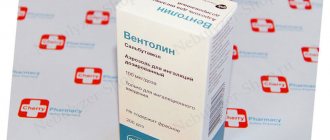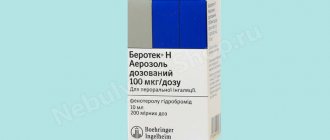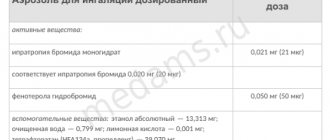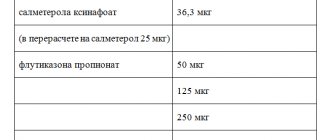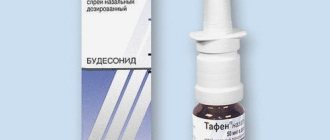Atrovent for inhalation is available in the form of a solution, aerosol and capsules with powder. Convenient to use is the solution, which must be diluted with saline before use - 2-3 ml of an additional component per 2 ml of the drug. Atrovent can be used by adults at any age; in pediatric practice, its use under 6 years of age is undesirable.
The price of Atrovent inhalation solution ranges from 250 rubles.
Release form of the drug
There are several forms of release:
- Aerosol Atrovent. It is a liquid without color or visible particles. A canister equipped with a mouthpiece contains 200 or 300 doses.
- Solution. It is also used for inhalation. The bottle may contain different dosages (20, 40 or 100 ml). The container contains a dropper nozzle.
- Atrovent powder is used for inhalation. The package contains 100 capsules of 200 mcg.
- Aerosol intranasal. The bottle contains 200, 300, 400 or 600 doses. The container is equipped with a special tip.
The drug is not used for intravenous administration, no matter how severe the disease. As for which form of the drug Atrovent is more effective, there is no clear answer. The inhalation solution has the following advantages:
- the active substance easily enters the alveoli of the lungs;
- Atrovent is excellent for treating diseases in older people who have contraindications to the use of other forms of medication, as well as in children under 5 years of age;
- a nebulizer allows you to spray liquid onto microscopic particles, which improves and accelerates the effect of the drug;
- this form of Atrovent does not contain freon;
- when treating a disease with obstruction, the drug can be combined with other drugs.
Metered aerosol also has certain advantages. One injection contains a certain dose. The canister is small in size, so you can always carry it with you so as not to disrupt the treatment regimen for the disease. The conditions for administering the drug are unlimited. The aerosol allows you to achieve a quick effect in the treatment of respiratory diseases.
Berotek and Atrovent
Berotec and Atrovent are drugs with identical effects, have bronchodilator properties, and can be used to treat minor diseases of the respiratory system. Both of them will not help with bronchospasm, but they can prevent its development.
Berotek has a larger list of contraindications in comparison with the drug in question, because its main active ingredient is fenoterol. It negatively affects the functionality of many organs, so the drug cannot be used for heart pathologies, heart rhythm disturbances, and unstable blood pressure.
Berotek is appropriate to use for treatment if Atrovent acts as a suspected irritant and allergy provocateur.
pharmachologic effect
The solution helps relax muscles and dilate the bronchi. The likelihood of spasm occurring is reduced. The medicine reduces the secretion of the glands of the mucous membrane, while the discharge of sputum during the disease is not impaired. The drug Atrovent prevents the narrowing of the bronchi, which is a consequence of the influence of cigarette smoke or cold air.
Pharmacology of the drug Atrovent
The medicine slightly reduces muscle tone. Inhalations with the solution are the safest, since here the active substance practically does not enter the systemic bloodstream. Normalization of the respiratory system in a patient with diseases of the lungs and bronchi occurs within 15 minutes. The result lasts up to 6 hours. The disease can be kept under control.
The drug Atrovent has a local effect in the respiratory tract. Only 30% of the drug reaches the lungs, and the rest ends up in the stomach, where it is neutralized.
What to choose - solution or aerosol?
Solution and aerosol are considered the two main forms of drug release against many inflammatory diseases associated with the respiratory system. When choosing the most suitable form, many different factors must be taken into account. Often the choice depends on the expected results of treatment and the characteristics of the pathology that should be eliminated.
When treating diseases of the respiratory system, the drug must act on a larger area in order to quickly eliminate the source of inflammation and restore the mucous membrane. In this case, drops are not suitable, since they only reach a certain area of the mucous membrane. Therefore, it is better to use an aerosol, since it penetrates the respiratory tract much better than solutions and evenly covers the surface of the mucous membrane.
However, sometimes sprays are ineffective and you have to use medicinal drops. Most often, solutions are used in the treatment of diseases such as sinusitis. In this case, the drug should penetrate only the area that connects the nasal passage to the sinuses. It is difficult for a spray to get into this area, and therefore it is better to use droplets.
Indications
The drug Atrovent is indicated in the presence of the following diseases:
- obstructive pulmonary disease with airflow limitation;
- emphysema (abnormal expansion of the air space of the distal bronchioles);
- mild to moderate bronchial asthma;
- bronchospasm accompanying colds or surgery;
- too active production of mucous secretion;
- preparation for surgery.
Atrovent can be used for primary treatment or for maintenance therapy. The intranasal solution is used for the treatment of chronic rhinitis, in which there is intense inflammation of the mucous membrane, accompanied by copious discharge.
In children, Atrovent is used to treat asthma accompanied by excessive phlegm production. Moreover, it does not have a negative effect on the heart and blood vessels. For children, it is better to use an inhalation solution.
Analogs
Level 4 ATC code matches:
Spiriva
Analogs of the drug are the following products: Ipravent (aerosol), Ipratropium Steri-Neb (solution for inhalation), Ipramol Steri-Neb (solution for inhalation), Spiriva (solution, capsules), Truvent , Troventol (aerosol), etc.
Which is better: Atrovent or Berodual?
Both of these drugs belong to the same group of drugs with a bronchodilator effect. However, Berodual is a complex product that contains the substances ipratropium bromide and fenoterol hydrobromide . Atrovent has a relatively slow therapeutic effect on the body, so it is not used to relieve severe attacks. Berodual, due to the combination of two strong components, effectively and quickly relieves bronchial spasms. But it should be noted that the drug Berodual has a wider list of side effects and contraindications. Consequently, Atrovent is more often used in primary therapy.
Conditions of release and storage
You can purchase Atrovent solution only with a doctor's prescription. It is stored in a dark place at temperatures up to 25 degrees. The shelf life depends on the form of the product. The inhalation solution is stored for 5 years, and the metered-dose aerosol is stored for 3 years.
The cost of the drug ranges from 315–400 rubles. The drug has analogues: Ipravent, Berodual, Hydrocortisone.
Atrovent price, where to buy
At any pharmacy you can buy Atrovent aerosol, the price of which ranges from 350 to 400 rubles per 10 ml can. The price of Atrovent for inhalation is on average 240 rubles per 20 ml bottle.
- Online pharmacies in RussiaRussia
ZdravCity
- Atrovent N aerosol for in.
dosage 20mcg/dose 200 doses 10mlBoehringer Ingelheim RUB 327 order - Atrovent solution for ing 0.25 mg/ml 20 mlIstituto de Angeli Srl
RUB 201 order
Dosage and application features
The patient must be able to correctly use Atrovent during exacerbation of the disease or during maintenance therapy. When switching from one form to another, the taste may change. This does not affect the effectiveness of Atrovent in any way. It is prohibited to change the daily dose prescribed by the doctor on your own.
If there is no effect for a long time, or the patient’s condition rapidly worsens, it is necessary to consult a doctor to change the tactics of treating the disease or adjust the dosage.
Dosage
It is selected on an individual basis. One drop of solution contains 0.0125 mg of the main active ingredient. 1 ml of product contains 20 drops. The daily dose depends on the severity of obstructive bronchitis, as well as on the individual characteristics of the patient.
The dosage of the solution depends on the type of treatment. For maintenance treatment, adults are prescribed 40 drops of the drug up to four times a day with a maximum daily dose of 8 ml (2 mg). Young patients from 6 to 12 years old will have to take 20 drops (the allowed amount per 24 hours is 8 ml). Children under 6 years old - from 0.4 to 1 ml, and the maximum daily dose does not exceed 4 ml.
When treating acute bronchospasm, the dose of the drug does not change. It can be used once in combination with other drugs or repeatedly until the patient's condition is stabilized.
Before use, the medicine must be diluted in a 0.9% sodium chloride solution so that the total amount is 3-4 ml. Inhalations are done using a nebulizer. The prepared solution must not be used again. The procedure requires a special tip or mask. If a centralized oxygen system is used to treat the disease, then the flow rate per minute is taken into account - 6-8 ml.
Terms of use
If the patient needs to administer several doses at once, the interval between them should be at least 1 minute. Shake the medicine package before use. Each form has its own characteristics of use.
Use in pediatrics
For young children, the medicine is used as a solution in a nebulizer.
A dosed aerosol drug (spray) can cause reflex laryngospasm (spasm of the glottis) or bronchospasm in young children.
Procedures with this Atrovent are widely used in pediatrics to relieve bronchospasms during bronchitis, which in childhood often develops against the background of acute respiratory viral infections.
Procedures for children are prescribed to relieve laryngospasm in acute laryngitis, a disease that is also very common in childhood against the background of acute respiratory viral infections. When relieving acute pathological processes, it should be remembered that Atrovent does not act instantly. Its action begins after 15 minutes.
In older preschool and school age, against the background of allergic processes and reduced immunity, chronic diseases of the bronchopulmonary system with bronchospasms can develop. For their treatment, Atrovent is used as part of complex therapy.
Aerosol for inhalation
First, you need to press the cylinder valve 2 times until an aerosol cloud appears. The application procedure is as follows: you need to remove the cap from the container, exhale air from the lungs, turn the container down with the tip, which is tightly covered by the lips. Then you need to take a deep breath, while sharply pressing the bottom of the bottle. To achieve a good effect, you will have to hold your breath for a few seconds.
Atrovent aerosol
Atrovent for dry cough
In otolaryngology, along with the effectiveness of anticholinergic drugs, the issue of their safety is important. Atrovent is one of the most studied m-anticholinergic drugs.
Its mechanism of action is based on the ability to prevent or suppress the reaction of acetylcholine with cholinergic receptors, thus reducing the influence of the parasympathetic nervous system on the functions of certain organs. Atrovent solution for inhalation reduces the likelihood of side effects and creates a high concentration of the active substance in the affected areas.
articles
Solution for inhalation
It must be diluted before use. If the volume of liquid is large, then it should be stored in the refrigerator for no more than 24 hours. Before use, the product is heated to 20 degrees.
Atrovent for dry cough in children
Atrovent for inhalation is available in the form of a solution, aerosol and capsules with powder. Convenient to use is the solution, which must be diluted with saline before use - 2-3 ml of an additional component per 2 ml of the drug. Atrovent can be used by adults at any age; in pediatric practice, its use under 6 years of age is undesirable.
The price of Atrovent inhalation solution ranges from 250 rubles.
Main characteristics of the drug Atrovent
Atrovent is a drug for inhalation with a pronounced bronchodilator effect.
| Pharmacological group | Bronchodilators that prevent the development of bronchospasm |
| Release form | Solution for inhalation, aerosol for single injection |
| Compound | The main active ingredient is ipratropium bromide, auxiliary ingredients are ethanol, distilled water, citric acid (present only in aerosols) |
| Application diagram | For exacerbation of chronic pathologies 2-3 times a day, for acute respiratory tract diseases - 4 times a day |
| Storage conditions | In a cool place, without freezing, avoid direct sunlight on the packaging. |
| Best before date | Inhalation solution – 5 years, aerosol – 2 years |
Mechanism of action
The mechanism of action is based on the property of the main active ingredient ipratropium bromide - it expands the bronchi and relaxes their muscles. The result is a decrease in their tone, which ensures the patency of the bronchi for air. In addition, Atrovent:
- increases sputum production;
- does not interfere with the discharge of mucus;
- prevents bronchospasm;
- increases the volume of air supplied to the lungs during pneumonia and bronchial asthma.
During inhalation, the drug is quite difficult to absorb from the mucous membrane, only 10% of the total amount of the drug reaches the diseased bronchi, the rest settles on the oral mucosa.
For which cough is it more effective?
Atrovent is most effective for dry coughs, when sputum production does not occur or occurs at a slow pace. In this case, inhalation procedures are recommended to be performed 3-4 times a day. But as soon as sputum begins to form and disappear, the number of procedures per day is reduced by 2 times.
It is advisable to use Atrovent for wet coughs if there is a high probability of developing bronchospasm.
We recommend reading the article about inhalations for bronchitis. From the article you will learn whether it is possible to breathe over steam during bronchitis, how to carry out inhalations for bronchitis with a nebulizer, as well as about medications and what to use for inhalations for bronchitis at home.
And here is more information about the main types of inhalers.
Recipe in Latin
The prescription in Latin is written with the term ipratropium bromide , although the name of the drug in the same language is designated as Atrovent.
Is it possible during pregnancy and lactation?
During pregnancy, inhalations with Atrovent can be carried out, but not in the first trimester - there is no reliable data on the effect of the main active ingredient on the intrauterine development of the fetus, so gynecologists prefer not to take risks.
Breastfeeding is a conditional contraindication for the use of the drug in question. You need to consult with doctors and make decisions only with specialists and on an individual basis.
Can Atrovent N cause an overdose?
Atrovent N cannot cause an overdose because it would require inhaling 500 doses at a time. Even if this happens (although this is physically impossible to do), then only a small fraction of the main active substance will get directly into the bronchi.
Instructions for use Atrovent, dosage
The instructions for use of Atrovent state that the drug is first diluted with saline solution, and the dosage is calculated individually, although there are general recommendations - no more than 40 drops can be used for one inhalation. The frequency of procedures per day is a maximum of 4 times.
How to use for inhalation in adults
For inhalation by adults, Atrovent must be diluted with saline solution (0.9%) before use. The latter is added to the required dose of the drug in such an amount that the total volume is a maximum of 4 ml.
1 ml of Atrovent is 20 drops, so you can use a syringe without a needle to introduce the medication into the inhaler/nebulizer. If a large volume of the drug was diluted at once, it should be stored only for 24 hours and in the refrigerator. Before use, you need to warm it up in your palms or in the room to 20 C.
The duration of the procedure depends on the amount of solution at one time - you must wait for it to completely evaporate. During inhalation, you need to take a deep breath through your mouth, then hold your breath for 1-2 seconds, and exhale through your nose. Breathing should be calm and deep.
Inhalations for children through a nebulizer
Children are given inhalations with Atrovent through a nebulizer only for diseases of the bronchi; the procedure is especially highly effective for “wet” asthma, a type of pathology characterized by the formation of a large amount of sputum.
No more than 3 procedures are allowed per day, but if the child is bothered by acute attacks of suffocation against the background of bronchospasms, the doctor can shorten the interval between inhalations.
Intranasal aerosol
The contents of the bottle are injected into the nasal passage three times a day, 2-3 doses. The tip of the aerosol can must be constantly cleaned so that the drug does not remain on it.
Rules for use in a nebulizer
Before inhalation, Atrovent is diluted with 0.9% saline solution - the resulting liquid should be 4 ml. After this, the medicine is poured into the nebulizer.
Attention! Atrovent is suitable for therapy with any type of nebulizer, as well as a special oxygen system.
After diluting the medicine, you need to follow the same recommendations as when using a conventional inhaler - slowly exhale and inhale the medicine using the device. You are allowed to use a nebulizer no more than 2 times a day.
Do not miss useful information: Instructions for use of Spiriva Respimat
Special instructions and overdose
When treating pregnant women, specialists compare the danger of the disease to the health of the mother and the risk to the fetus. Preclinical studies have shown that inhalation does not have a toxic effect on the embryo.
There is no data on whether the main active ingredient can pass into breast milk. The likelihood that the drug in the form of an inhalation solution will be found in it is low. Even if ipratropium bromide gets into milk, it does not accumulate in large quantities.
The drug does not affect women's ability to have children. As for overdose, there are no specific symptoms. The patient's accommodation is impaired, the heartbeat accelerates, and dry mouth appears. To improve a person’s well-being, symptomatic therapy is performed.
Atrovent inhalations should not be used for emergency relief of an acute attack of bronchial asthma, since the effect of the drug develops more slowly than necessary. If a person has a disease such as cystic fibrosis, gastrointestinal motility may slow down. This condition is characterized by nausea, problems with stool, and discomfort.
After inhalation, it is better to refrain from driving a car or working with moving machinery. When treating children, caution is exercised if they are diagnosed with cerebral palsy, Down syndrome, or organic brain damage.
Drug interactions
The drug Atrovent enhances the effect of beta-agonists. The presented remedy can be used in conjunction with bronchodilators, the effect of which becomes more effective.
Tricyclic antidepressants, quinidine, and drugs for the treatment of Parkinson's disease enhance the effect of Atrovent. If there is no effect 30 minutes after taking the medicine, you should immediately consult a doctor.
Interaction
If Atrovent is prescribed simultaneously with cromoglycic acid, the effectiveness of both drugs may be reduced. With simultaneous treatment with xanthine derivatives and β2-adrenergic receptor agonists, a more pronounced bronchodilator effect is observed.
The anticholinergic effect of Atrovent is enhanced by simultaneous therapy with antiparkinsonian drugs, tricyclic antidepressants, and quinidine.
Cisapride reduces the severity of the influence of Atrovent. When combined with Atrovent and β2-adrenergic receptor agonists, an exacerbation of the condition in patients with angle-closure glaucoma is possible.
Aerosol treatment should not be practiced in parallel with disodium cromoglycate, since the two aerosols may interact physically.
Possible contraindications
Not everyone can use Atrovent. There are the following contraindications for use:
- Too high sensitivity to the main substance or auxiliary components.
- First trimester of pregnancy.
- Allergic reaction to atropine.
Caution must be exercised if the patient is diagnosed with angle-closure glaucoma, urinary tract obstruction, or prostate enlargement is detected in men. Doctors pay special attention to children under 6 years of age.
For what cough is Atrovent prescribed?
In otolaryngology, along with the effectiveness of anticholinergic drugs, the issue of their safety is important.
Atrovent is one of the most studied m-anticholinergic drugs. Its mechanism of action is based on the ability to prevent or suppress the reaction of acetylcholine with cholinergic receptors, thus reducing the influence of the parasympathetic nervous system on the functions of certain organs. Atrovent solution for inhalation reduces the likelihood of side effects and creates a high concentration of the active substance in the affected areas.
articles
Description
Atrovent production belongs to the German pharmaceutical company Boehringer Ingelheim International. The drug has different release forms :
- Aerosol for inhalation . Presented in a metal bottle with a dosage of 10 ml. (equivalent to 200 doses), equipped with a spacer and dosing valve.
- Solution for inhalation . Amber glass bottle, 20 ml. placed in cardboard packaging along with annotation.
The active ingredient is ipratropium bromide, contained at the rate of 0.25 mg. per 1 ml. solution. It is an antagonist of m-cholinergic receptors, inhibits the action of acetylcholine, and blocks the influence of parasympathetic innervation.
The pharmacodynamic activity of the drug is enhanced by auxiliary components:
- benzalkonium chloride;
- sodium chloride;
- hydrochloric acid;
- disodium salt of ethylenediaminetetraacetic acid;
- distilled water.
The liquid is transparent, the consistency is homogeneous without visible particles.
When is it prescribed?
When choosing anticholinergic drugs, it is necessary to take into account the specifics and phase of the disease, age and functional indicators of the bronchopulmonary apparatus, which can change the bioavailability of the anticholinergic blocker.
Indications for use:
- severe forms of bronchial asthma;
- COPD (chronic obstructive pulmonary disease), including emphysema;
- bronchospasm as a response to infectious strains or surgery;
- preparation for diagnostic measures.
“Atrovent” for dry cough increases its productivity (increases the natural discharge of sputum from the tracheobronchial tree), relieves spasms, softens painful sensations in the throat, and improves the quality of breathing.
You can find out more about how to turn a dry cough into a wet one here.
Pharmacodynamics
The mechanism of action of Atrovent is based on the ability of the active substance to block m-cholinergic receptors of the smooth muscles of the respiratory tract without affecting the functions of the urinary and digestive systems .
It prevents and eliminates paroxysmal disorders of bronchial obstruction, the appearance of which was preceded by bronchospasm, swelling of the mucous membrane, exposure to cigarette smoke, and cold air. As a result, the smooth muscles of the bronchi relax, and the secretion of the bronchial glands decreases. "Atrovent" improves lung function in patients with respiratory failure.
For reference! With fine spraying, the effect of the medicine develops in the interval from 15 to 60 minutes and lasts up to 6 hours.
Price
The drug can be purchased with a prescription from specialized healthcare organizations. How much does Atrovent cost for inhalation? Minimum price for 20 ml. bottle – 203 rubles, maximum – 250 rubles. Aerosol for inhalation is more expensive. Average price for 10 ml. – 315 rub.
Instructions for use of "Atrovent" for inhalation
The principle of administration (schedule of administration and determination of dose) requires a separate analysis in each clinical case .
Independent adjustment of the daily/one-time norm is dangerous due to the development of undesirable effects on the immune, cardiovascular, urinary systems, digestive tract, visual organs, and skin. Consultation with a specialist will be required in the absence of positive dynamics in order to replace it with another drug.
Scheme for using Atrovent in maintenance therapy:
- Adults and children over 12 years of age inhale 2 ml. drug (1 ml = 20 drops), daily frequency of 3-4 procedures. The maximum permissible daily intake should not exceed 8 ml.
- Children from 6 to 12 years old : 0.5 – 1 ml. (10-20 drops) every 3-4 hours. In this case, the patient should not receive more than 1 mg. in a day.
The dosage for acute bronchospasm is increased, and the time interval between manipulations is determined by the doctor:
- children under 12 years of age inhale 20 drops (1 ml);
- over 12 years of age and adults - 40 drops with the possibility of repeated administration in order to stabilize subjective indicators.
It is optimal to carry out the procedure in a hospital setting under medical supervision . The course of inhalations is set on an individual basis, the average duration of treatment is 5 days with the possibility of repeated inhalations to prevent relapses and consolidate positive dynamics.
Nuance! "Atrovent" is used for combined inhalations with expectorant medications: "Ambrobene", "Berotecom", "Bromhexine".
"Atrovent" is diluted with 0.9% sodium chloride solution for every 1-2 ml. drug 3-4 ml. saline solution. The medicine is prepared for one inhalation. The duration of the procedure is controlled by the consumption of the prepared volume.
Contraindications
Patients with the following disorders are at risk:
- hypersensitivity to atropine, ipratropium bromide and other auxiliary elements;
- obstruction of the urinary tract;
- prostate adenoma;
- children up to 6 years old.
The limiting factor is suspicion of pregnancy and early gestation , the period of breastfeeding . Clinical studies have not confirmed embryotoxic and teratogenic effects, however, taking pharmaceuticals, especially in the first trimester of pregnancy, is always associated with risk.
When prescribing Atrovent inhalations, the doctor should be guided by the expected benefit of the drug for the woman and the potential threat to the fetus.
Side effects
Inhaled anticholinergic therapy may cause local irritation. Analyzing the results of clinical testing and practical reviews from patients, among the adverse reactions most often recorded were the following:
- headache;
- dizziness;
- gagging, nausea;
- bowel disorders;
- cough;
- sore and dry throat;
- tachycardia.
The appearance of these symptoms requires stopping the use of Atrovent and carrying out symptomatic therapy.
Advice! The correctness of inhalations must be checked in the elderly and children.
Failure to comply with the dosage regimen is dangerous due to increased risk of the following side effects :
- anaphylactic shock;
- redness and itching of the skin;
- atrial fibrillation;
- gastrointestinal motility disorder;
- bronchospasm and laryngospasm.
The entry of Atrovent into the projection of the eyes stimulates an increase in intraocular pressure. In patients prone to angle-closure glaucoma, the clinical signs of the pathology worsen: pain in the eyes, corneal edema, pupil dilation, and the ability to clearly see the image is impaired.
Replacement of "Atrovent"
You can find a synonym for m-anticholinergic blocker using specialized reference books or a pharmacist or doctor. "Atrovent" has a number of analogues that differ in dosage form, but are similar in their mechanism of action. Among them:
- "Ipravent" (aerosol);
- "Troventola" (aerosol);
- "Spiriva" (capsules, solution for inhalation);
- "Itrop" (tablets);
- "Vagos" (aerosol);
- "Arutropid" (capsules, solution and aerosol for inhalation);
- "Ipratropium bromide" (metered-dose aerosol, powder for inhalation).
A wide variety of generics on the pharmaceutical market allows you to buy an anticholinergic blocker at the lowest price, since the price range can differ by several hundred rubles. To achieve a positive therapeutic result, the dosage of the active substance is important. Therefore, ideally, the decision to replace Atrovent with a cheaper analogue should be made by a doctor.
What to choose: “Atrovent” or “Berodual”?
Both drugs belong to the group of m-anticholinergics and are characterized by pronounced bronchodilator activity. If the basis of “Atrovent” is exclusively ipratropium bromide, then “Berodual” has a combined composition (ipratropium bromide + fenoterol hydrobromide).
The combination of two active components enhances the pharmacological effect and effectively eliminates bronchospasm. “Atrovent” acts more gently on the body, while the therapeutic effect is less pronounced.
What is better, “Berodual” or “Atrovent”? For maintenance or primary therapy, preference is given to Atrovent. For moderate and severe pathologies, Berodual is more often used, given the wide list of contraindications and side effects.
Important! Do not freeze the drug, store at a temperature no higher than 30⁰C. Shelf life – 36 months.
Patient opinions
Marina:
I tested the effect of Atrovent on myself, I recommend it. Against the background of bronchitis, there were very strong wheezing in the chest, shortness of breath, and a feeling of lack of air. After the first day of treatment, the frequency and intensity of the cough decreased, and the pain in the chest area stopped. 2 ml was inhaled. 3 times a day, I did not notice any side effects.
Olga:
The child was prescribed Atrovent in combination with the expectorant drug Lazolvan. Initially, I was confused by the wide list of side effects, but the cough had already exhausted my son so much that he had to act.
We did inhalations for 4 days + 2 days (to prevent relapse, as the doctor advised), I was satisfied with the result. Cough productivity increased, breathing quality improved after the first procedure.
Conclusion
For rational treatment with Atrovent, control and safety of therapy, qualified assistance from a specialist will be required. With the correct dosage, the drug counteracts the development of bronchospastic reactions, improves lung function, and improves mucociliary clearance.
Source: https://phoenix-pharma.ru/pri-kakom-kashle-naznachajut-atrovent/
Side effects of the medicine
The patient may experience adverse reactions due to the use of Atrovent. These include:
- headache, dizziness;
- feeling of dry mouth;
- indigestion, nausea, vomiting, stomatitis;
- arrhythmia or tachycardia, atrial fibrillation;
- impaired accommodation of the eyes, blurred vision, redness and inflammation of the conjunctiva, disease of the cornea;
- decreased functionality of the sweat glands;
- urinary retention;
- paradoxical bronchospasm, cough, laryngospasm;
- allergic reaction in the form of skin rash, anaphylactic shock, angioedema.
If the medicine gets into the organs of vision, the patient may experience pain and increase intraocular pressure. In some cases, additional components can cause a narrowing of the bronchial lumen, worsening the course of the disease. Therefore, Atrovent should be taken after consultation with a doctor.
How does it interact with other drugs?
Before starting to use Atrovent, the patient must inform the doctor about all medications that he needs to take for health reasons. This applies to all medications, from antibiotics to medicinal herbs. This is due to the fact that Atrovent can have a negative impact on the safety and activity of the drugs taken by the patient:
- increases the strength of the bronchodilator effect of theophylline and beta-agonists;
- use with anticholinergics increases the antiparkinsonian properties of the drugs;
- the anticholinergic effect increases when taking Atrovent with antidepressants and quinidine.
The inhalation form of Atrovent can be used with many medications, but this should only be done according to a doctor’s indications.
Analogues of Atrovent are:
- Berodual;
- Salbutamol;
- Pulmicort.
These Atrovent substitutes should be taken only as prescribed by a doctor, and strictly in accordance with the dosages.
